How Many People Have Mental Health Issues?
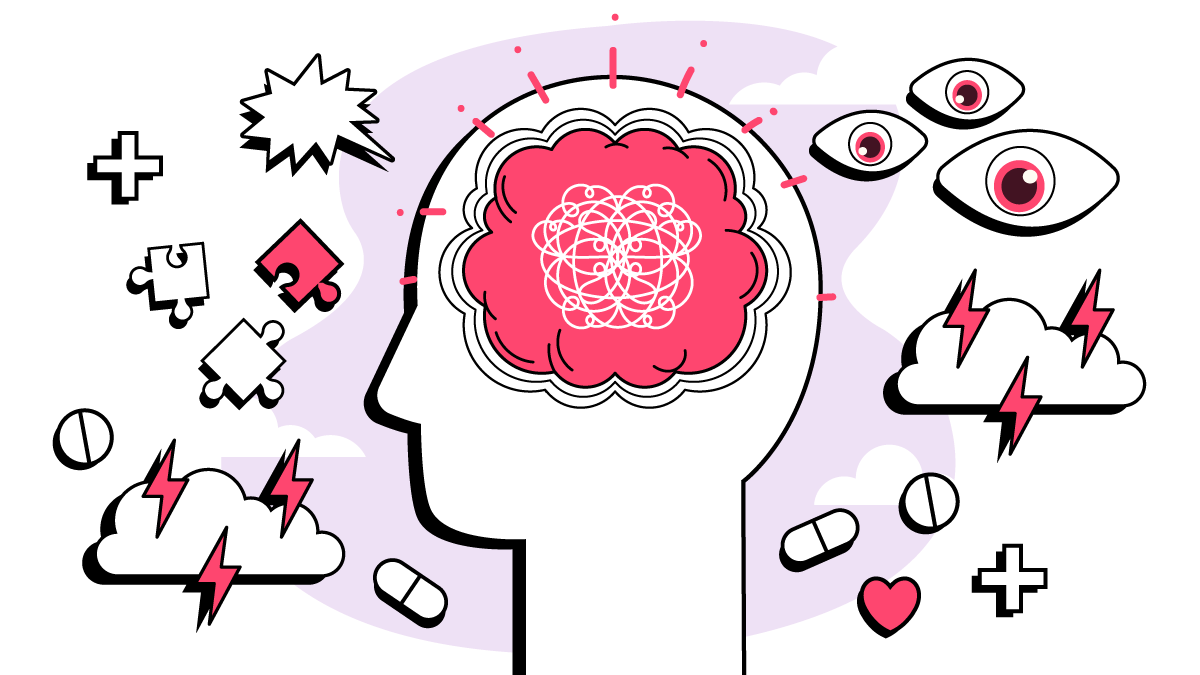
Report Highlights:
- 21% or 1 in 5 Americans deal with some type of mental illness [45].
- Severe mental illness affects 5.6% or more than 1 in 20 Americans [45].
- 23.2% or less than 1 in 4 children in the US also suffer from mental illness [44].
- Each year, mental illness affects 49.5% of adolescents and 27% of college students [23] [39].
- 25.8% of women suffer from mental disorders compared to 15.8% of men [45].
- 30.6% of young adults aged 18 to 25 have mental illness [45].
- A family history of mental illness increases the risk by 17% to 28% [46].
- 27.4% have anxiety and 22.3% have depression in the US. These are two of the most common mental illnesses [3].
- The COVID-19 pandemic increased anxiety and depression rates to 32.4% and 25.6% in 2020, up from 8.1% and 6.5% in 2019, respectively [3] [59].
- High social media use puts you at 3x higher risk of depression and 3.2x higher risk of anxiety [48].
- 5% to 10% of Americans are addicted to social media [19].
- Severe mental illness puts people at a 5% to 8% higher suicide risk [6].
- From 39.83 million (17.7%) in 2008 to 52.86 million (21%) in 2020, the number of mental illness cases increased by 32.7% [45].
- Only 46.2% of adults and 50.6% of children with mental illness receive treatment [57] [63].
- 67% of people with mental illness recover [4].
The rate of mental illness in the US has increased by 18.64%. From 17.7% (39.83 million) in 2008, it’s now at 21% (52.86 million) in 2020 [45].
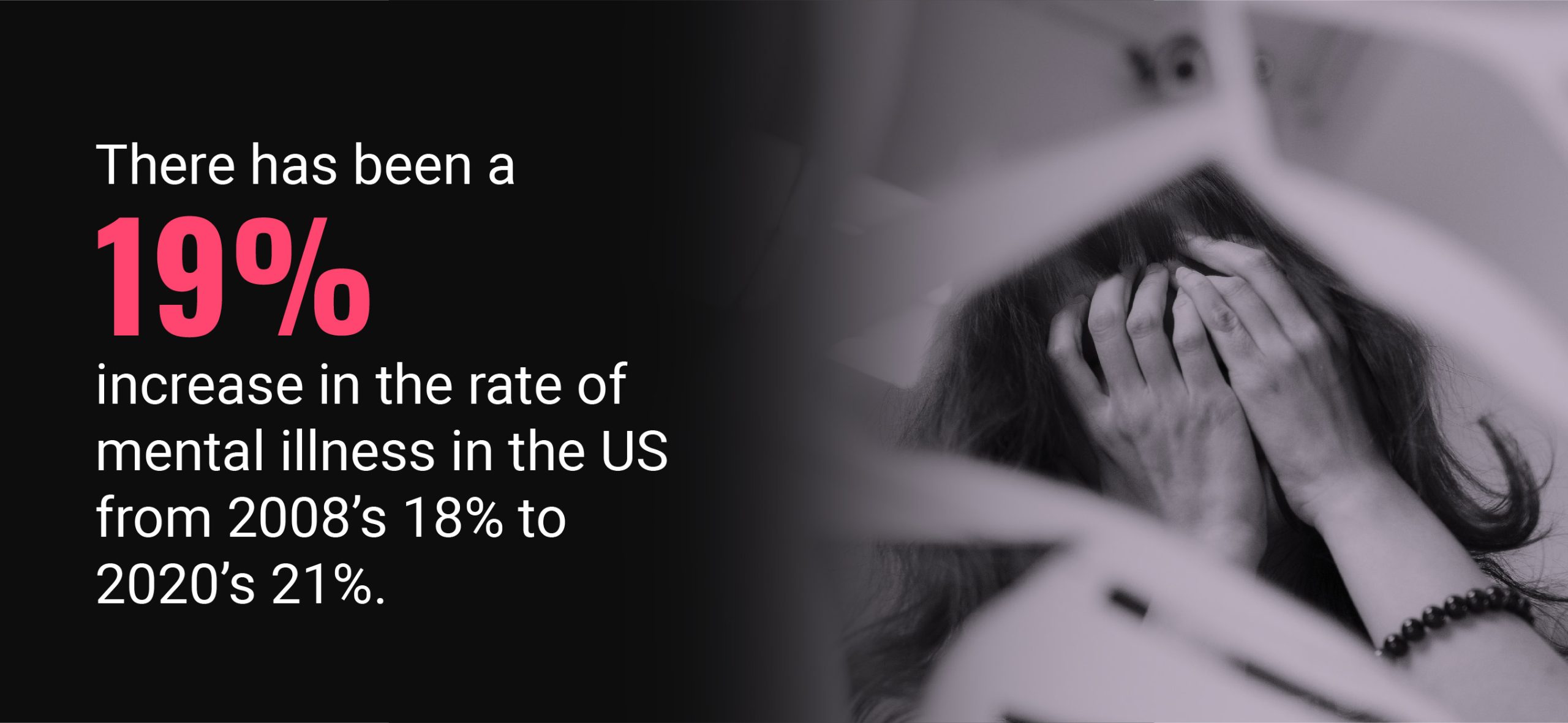
We especially saw rapid spikes in anxiety and depression cases, with the COVID-19 pandemic contributing to their increased rates.
Read on to learn more about the current mental health statistics in the US.
What Causes Mental Health Problems?
Mental illness may be hereditary, and genes increase the risk by 17% to 28%. Researchers found that these five mental health disorders share common genes [46]:
- Schizophrenia
- Bipolar disorder
- Depression
- Autism
- ADHD
Traumatic experiences can cause mental health problems. A high number of traumas increases the odds of developing anxiety by 6.8 times, depression by 5.9 times, and post traumatic stress disorder (PTSD) by 4.9 times [13]. A study shows that 90% of those exposed to lifetime trauma have psychiatric problems [16].
People dealing with chronic health diseases have a 2 times higher risk of developing anxiety and depression [7]. Of those with chronic physical diseases, 36.6% of them deal with mental illness [9]. The data came from the pooled estimates of 40 studies with 21,747 subjects.
Poverty and low income also contribute to mental illness. People who belong to this group are 1.5 to 3 times more likely to suffer from anxiety and depression [51].
People with five or more unhealthy habits have 5.4 times higher psychological distress levels at baseline than those with no unhealthy habits [18]. 20% of those who suffer from sleep problems also deal with mental illness [5].
Mental illness is also linked with substance abuse [30].
- Substance abuse affects 50% of those with severe mental illness.
- 53% of drug abusers and 37% of alcoholics have at least one diagnosis of serious mental illness.
- Of those with mental illness, 29% of them also deal with substance abuse.
Mental illness may also be caused by imbalances in brain chemistry. Neurotransmitter imbalance affects the way neurons normally function, increasing the risk of mental illness [43].
What is the Most Common Mental Disorder?
One of the most common mental disorders, anxiety affected 27.4% or 70.78 million Americans in 2021. This has decreased from 2020’s 32.4% or 83.36 million when the COVID-19 pandemic was just starting [3].
Depressive disorder is also a common mental illness. It affected 22.3% or 57.61 million Americans in 2021. Its prevalence also decreased from 2020’s 25.6% or 65.86 million individuals [3].
Between 2018 and 2019, 6.37% or 21.03 million Americans suffered from eating disorders [10].
Other common mental illnesses include:
- ADHD which affects 4.4% or 10.5 million Americans [37]
- PTSD which affects 3.6% or 9 million Americans [42]
- Bipolar disorder which affects 2.8% or 7 million Americans [38]
- Borderline personality disorder which affects 1.4% or 3.5 million Americans [41]
- Obsessive-compulsive disorder which affects 1.2% or 3 million Americans [40]
- Schizophrenia which affects 1.1% or 2.8 million Americans in 2020 [54]
How Many People Suffer from Mental Illness?
Each year, an average of 21% or more than 1 in 5 Americans suffer from mental illness symptoms [45].
55.3% or more than 1 in 2 Americans will receive a mental illness diagnosis at some point in their lifetime [26].
Debilitating mental disorders also affect children.
23.2% or less than 1 in 4 children currently deal with mental illness each year [44].

How Common are Mental Health Problems?
Mental illness is prevalent in the US that it affects 21% or more than 1 in 5 Americans in 2020. This translates to 52.86 million Americans suffering from mental disorders [45].
5.6% or more than 1 in 20 Americans also suffer from serious mental disorders. This means that 14.2 million Americans are living with major depression, schizophrenia, or bipolar disorder [45].
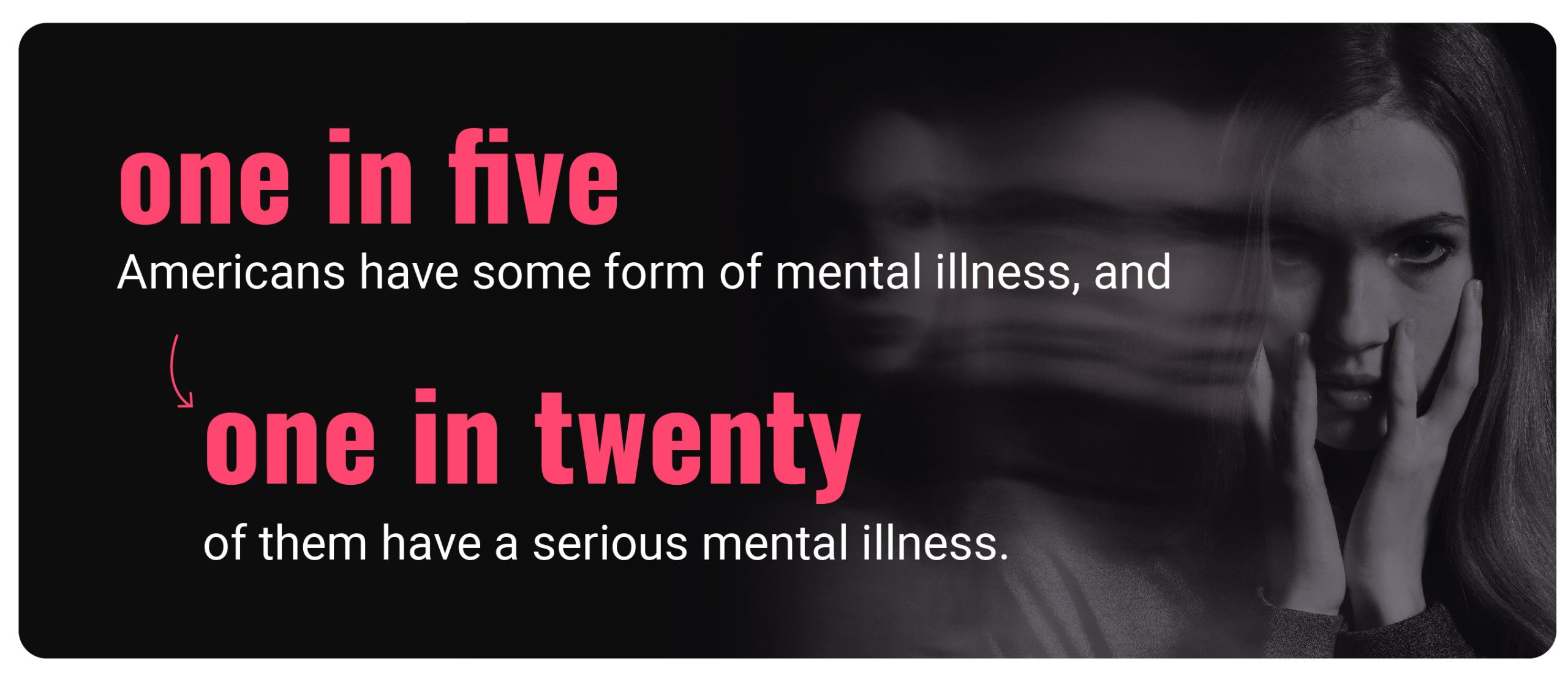
Who is Most Affected by Mental Health Issues?
Mental illness affects 25.8% of women, 30.6% of young adults (18-25), and 35.8% of multiracial people.
Mental Illness Prevalence Rate by Gender
25.8% or 33.59 million American women suffer from mental illness. Among men, mental illness affects only 15.8% of their population or 19.27 million [45].
Women tend to internalize their emotions. This results in depressive symptoms and withdrawal. This puts them at higher risk of depression and anxiety [56].
On the other hand, Men tend to externalize their emotions. This results in aggressiveness or impulsivity. This increases their risk of antisocial disorders as well as substance use disorder [56].
Men’s Mental Health Statistics
Mental illness affects women more than men. However, some mental disorders are more prevalent in men.
11.6% of current substance users and 15.2% of former substance users are men. Among the female gender, 8.3% are current substance users and 10.3% are former substance users [2].
Men are also more likely to suffer from substance use disorder than women. Of those with substance use disorder, 11.5% are men compared to only 6.4% of women [17].
Antisocial personality disorder also occurs more commonly in men than in women. Of those with antisocial personality disorder, 47.2% are men while 31.5% are women [67].
Schizophrenia is more prevalent in men than in women. In 2019, schizophrenia affected 0.48% of the male population in the US compared to 0.46% of the female population [14].
Bipolar disorder is higher in men than in women. Men have a 2.9% bipolar disorder prevalence rate compared to 2.8% in women [38].
ADHD also affects males more than females. 12.7% of boys compared to 5.6% of girls have ADHD [44].
The same trend occurs in adult ADHD. 5.4% of adult males in the US have ADHD. Adult ADHD affects 3.2% of adult females [25].
Mental Illness Prevalence Rate by Age Group
30.6% of young adults (18-25 years) suffer from a mental illness. This affects 10.24 million of their population [45].
Mental illness affects older adults (above 50 years) the least. Only 14.5% or 16.95 million of their population have mental illness [45].
Mental Illness Prevalence Rate by Race
35.8% of people who identify with two or more races have mental disorders, affecting 1.69 million individuals [45].
The second most affected race is non-Hispanic Whites. 22.6% or 35.62 million of their population suffer from mental disorders [45].
This disease affects Asians the least. Only 13.9% or 2 million of their population have mental illness [45].
Factors that contribute to the disparities include:
- Presence and prevalence of mental illness risk factors
- Access to medical care and mental health services
- Mental disorder stigma
- Language barriers
- Likelihood of seeking and receiving mental health care
- Insurance
Mental Illness Prevalence Rate by Socioeconomic Level
24% or 18.34 million of those with some college deal with mental disorders. It affects those with high school diplomas the least. In this population, mental illness occurs in 19% or 13.17 million people [45].
26.3% or 9.81 million Americans whose income falls under 100% poverty level have mental illness. It affects those whose income is above 200% poverty level the least. Only 18.7% or 31.45 million of them deal with a mental disorder [45].
Mental Health Statistics Among Teens and Young Adults
49.5% of adolescents (13-18 years) have had some form of mental illness at some point in their lives [39].
22.2% of them suffer from severe mental illnesses [39].
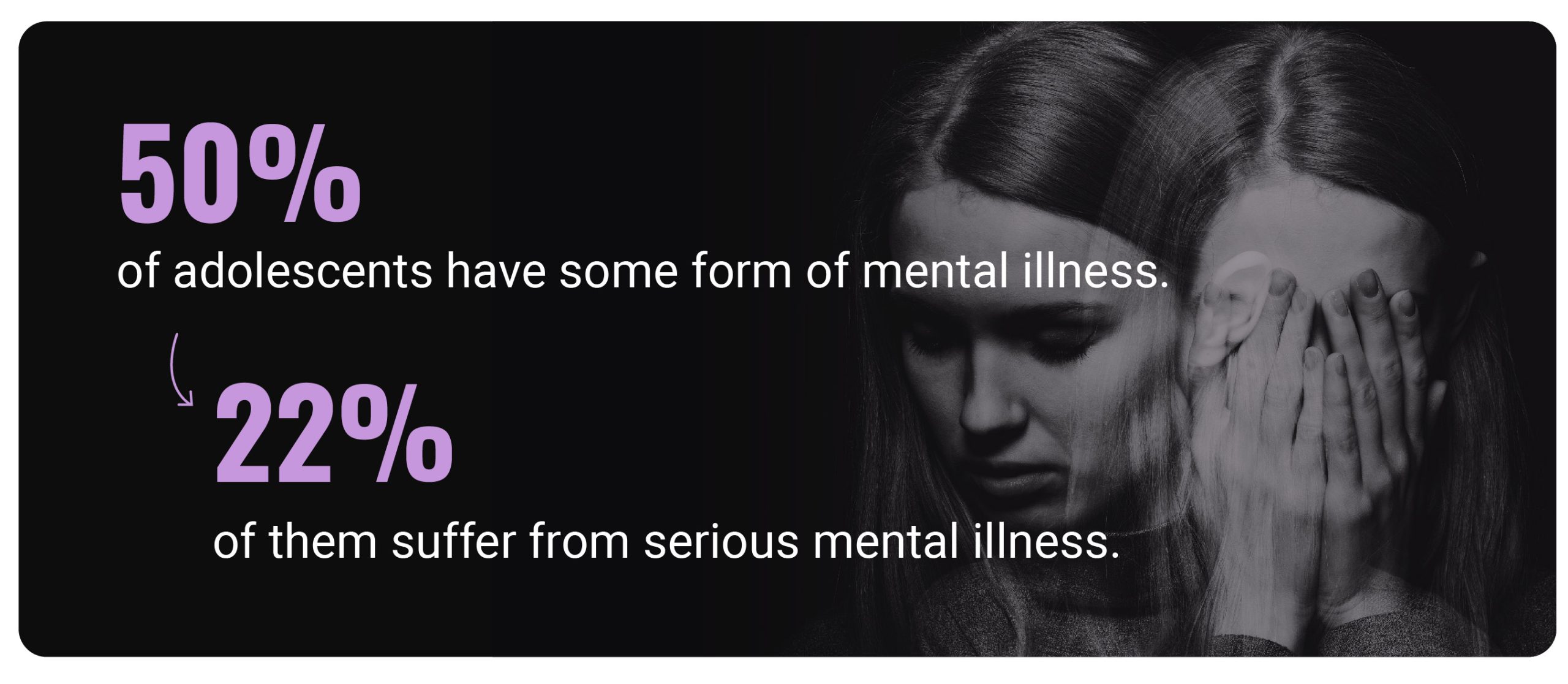
Teen Mental Health Statistics
According to the Centers for Disease Control and Prevention, 36.7%, more than 1 in 3, or one-third of high school students deal with persistent negative feelings like hopelessness or sadness. This increased by 40% from 2009 [12].
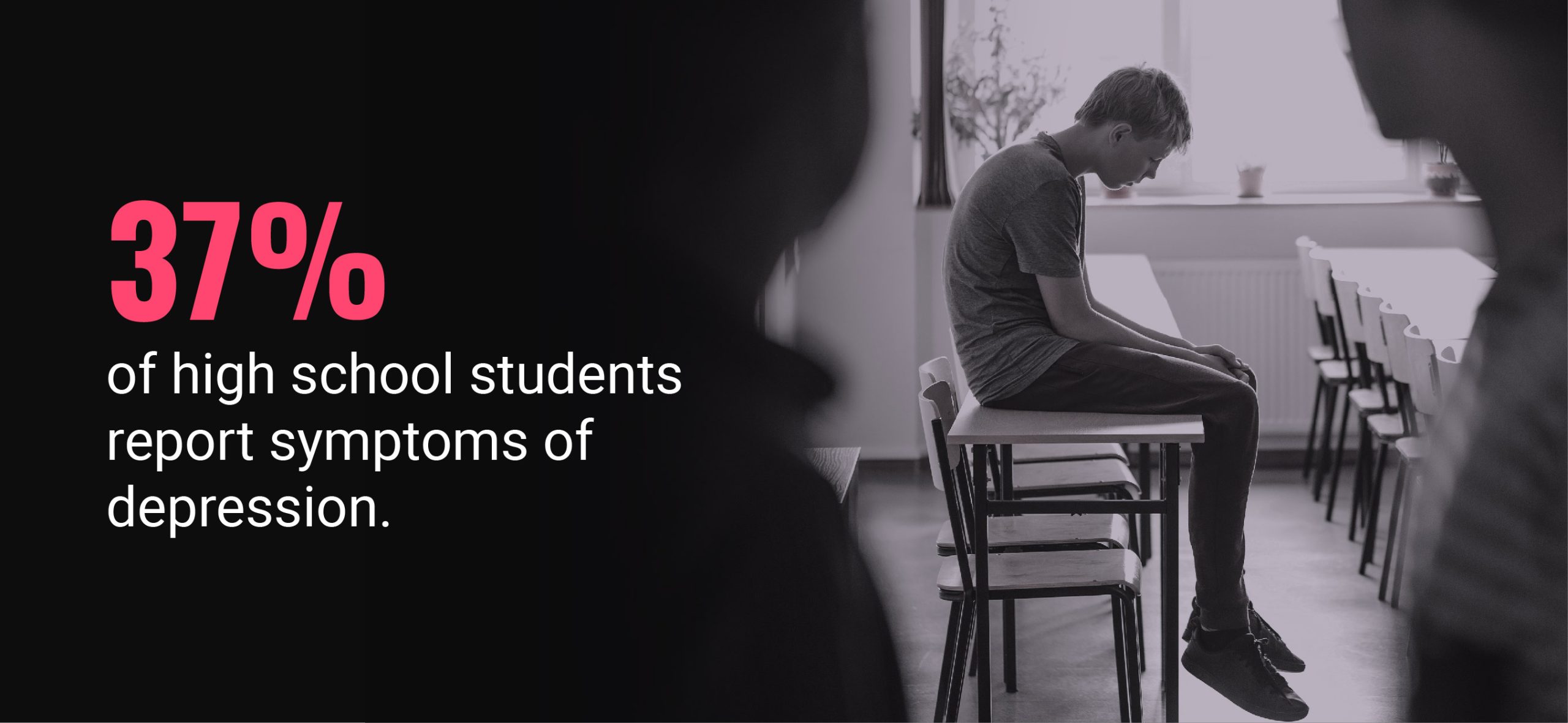
Of those who took a depression screen in 2020, 90.2% or more than 9 in 10 adolescents (11 to 17 years) scored for moderate to severe depression [8].
Among young adults (18 to 24 years), 86.4% or less than 9 in 10 scored the same [8].
Moderate to severe anxiety also occurred in 82.9% or more than 8 in 10 adolescents who took an anxiety screen in 2020 [8].
Of the young adults who took the same test, 79.7% of them scored for moderate to severe anxiety [8].
From January to September 2020, suicidal thoughts, suicidal ideations, and self-harm also increased among teens. These negative thoughts affected an average of 49% of teens monthly, the highest of which was 52% in March 2020 [8].
The COVID-19 pandemic contributed to the sudden spike in numbers. Isolation, loss of contact with peers, and uncertainty led to higher mental illness rates.
College Students Mental Health Statistics
Mental health problems affect 27% or more than 1 in 4 college students each year [23].
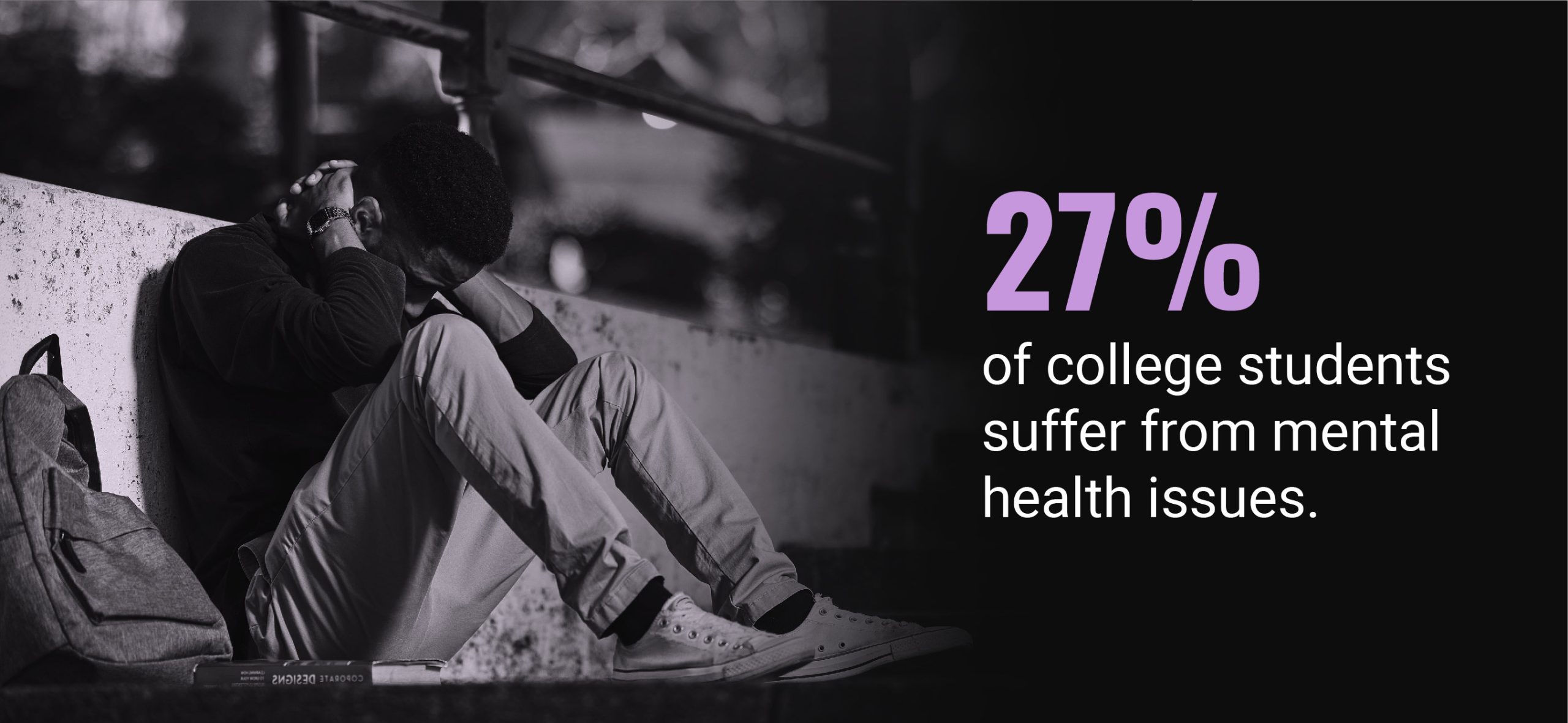
About 11.9% of them have some form of anxiety disorder. It’s the most common type of mental illness that affects college students [47].
Depression is the second-most common mental disorder affecting college students. It occurs in 7% to 9% of their population [47].
9.5% of 2,822 college students screened positive for some form of an eating disorder. It affected 13.5% of the female and 3.6% of the male college students [47].
Bipolar disorder symptoms occur in about 3.2% of college students. They met the criteria for this disorder upon testing [47].
ADHD also occurs in 2% to 8% of college students. Of the students who receive disability services, 25% of them have ADHD [47].
Suicidal thoughts also affect 20% or 1 in 5 college students. Of this percentage, 20% of them reported self-harm and 9% reported suicide attempts [66].

Mental illness has an early onset of effects and peaks in young adulthood. By the time they’re 25 years old, 75% of those with mental illness already had their first onset. Among patients with schizophrenia, 62% of males and 47% of females had schizophrenia symptoms before they reached age 25 [47].
COVID-19 Pandemic and Mental Health Statistics
In 2020, the COVID-19 pandemic caused a spike in the prevalence rate of anxiety at 32.4%. 83.36 million Americans reported anxiety symptoms [3]. In 2019, the prevalence rate was only 8.1% and affected 20.67 million people [59].
The same trend was also observed in the depression prevalence rate.
As the pandemic spread throughout the country, the depression rate also increased to 25.6% from 6.5%. It affected 65.86 million Americans, up from 16.59 million in 2019 [3] [59].
Anxiety and depression rates increased by 24.3 and 19.1 percentage points in just a year, respectively. Anxiety affected 62.69 million more individuals. 49.28 million more people also suffered from depression.
As the pandemic raged on, the anxiety rate across the globe ranged from 6.33% to 50.9% and depression rate from 14.6% to 48.3% [64].
As for PTSD, prevalence rate ranged from 7% to 53.8% and stress level rate from 8.1% to as high as 81.9% [64].
Psychological stress prevalence rate also ranged from 34.43% to 38% globally [64].
The COVID-19 pandemic significantly affected people’s mental health that their symptoms could easily meet the criteria for clinical psychological distress.
Social Media and Mental Health Statistics
Using 7 to 11 social media sites puts young adults (18 to 32 years) at a 3 times higher risk of developing depression. They also have a 3.2 times higher risk of developing anxiety [48].
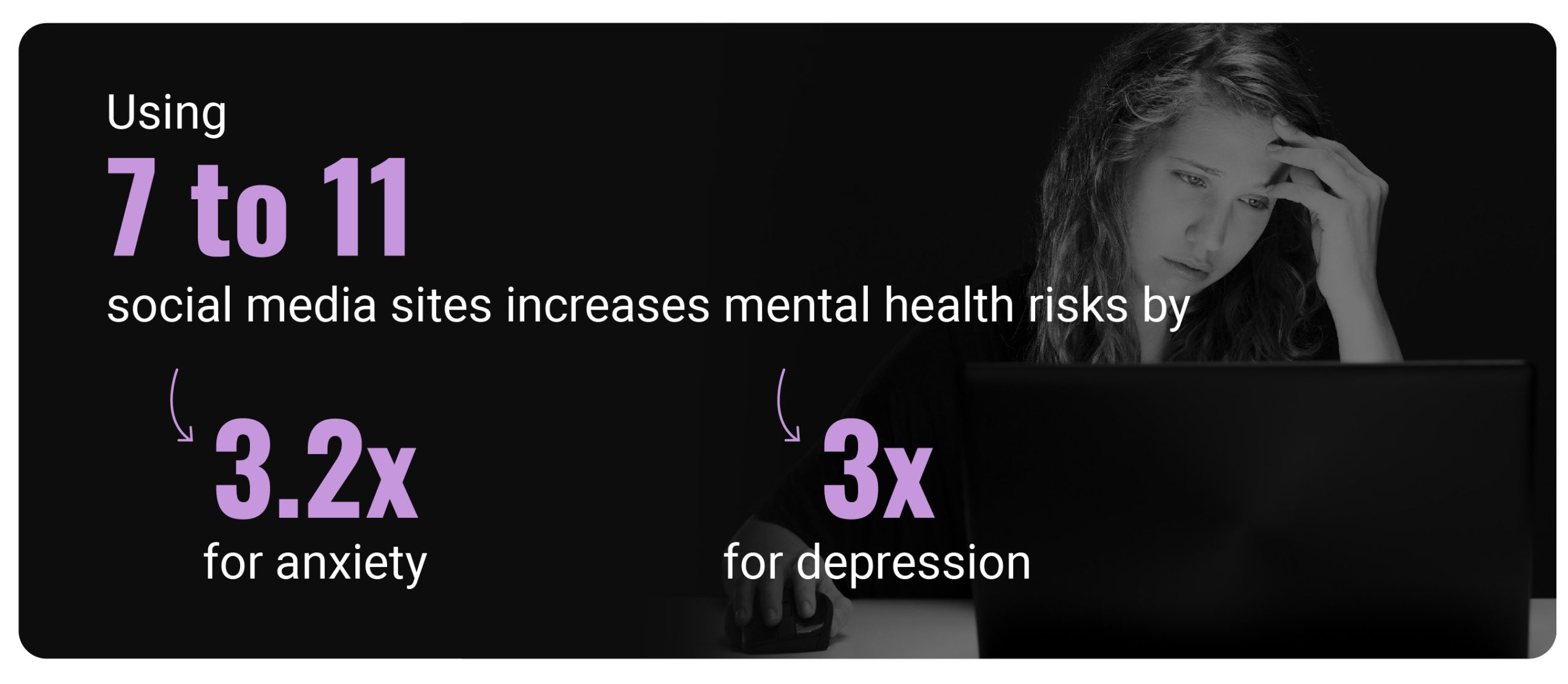
A study also found that individuals who use social media report a 70% increase in the symptoms of depression [24].
Three or more hours of social media per day also affect the mental health of adolescents. 27.2% of those who spend over three hours of their day on social media have poor mental health [52].
Visiting or using social media platforms at least 58 times weekly makes you 3.4 times more likely to develop depression symptoms compared to those who use social media at least nine times weekly [49]. They also have a 2.2 times higher risk of developing body image problems and eating disorders [60].
7 in 20 teenage girls and 3 in 20 teenage boys using Instagram say the photos make them feel bad about their bodies [62].
Is Social Media Addictive?
81% of teens and 72% of adults in the US use social media [55].
5% to 10% of social media users have social media addiction [19].
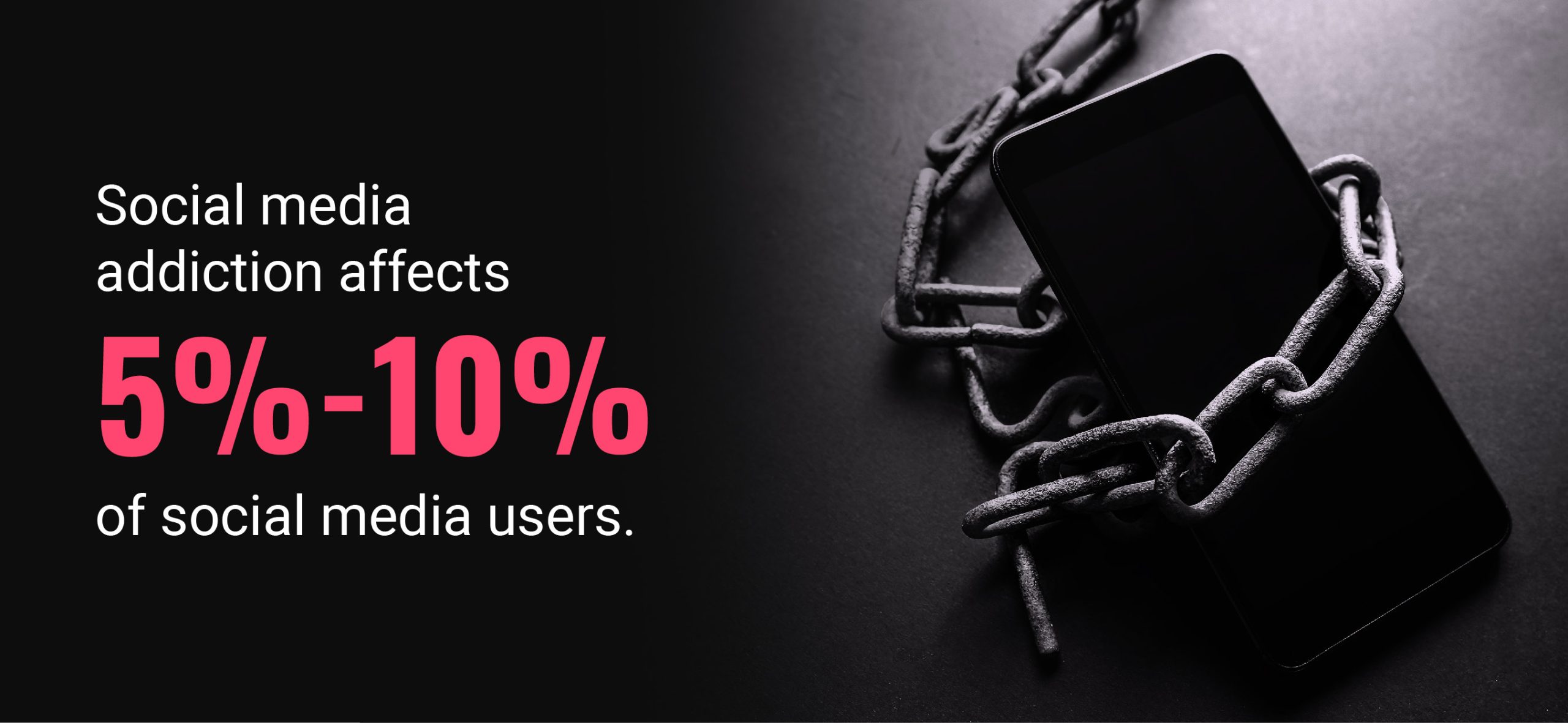
20% of those with one or more social media accounts say they feel compelled to check their phones at least once every 30 minutes [21]. Not doing so makes them feel anxious.
94% of college students admit feeling troubled when they don’t have their phones [27].
80% of them even say they feel some jealousy when they see people holding their phones [27].
If their phones got stolen or lost, 70% admit they’d feel depressed, panicked, helpless, and anxious [27].
Similar to addictive drugs, using social media also stimulates our brain’s pleasure and reward centers [20]. The more we engage in social media activities, the higher the risk of social media addiction.
Similar to drug addiction, social media addiction also alters moods and causes interpersonal conflicts with other people. People with social media addiction may also develop tolerance, withdrawal symptoms, and relapse.
Mental Illness Mortality Rates and Statistics
People who suffer from severe mental illness also have a 5% to 8% higher risk of suicide [6].
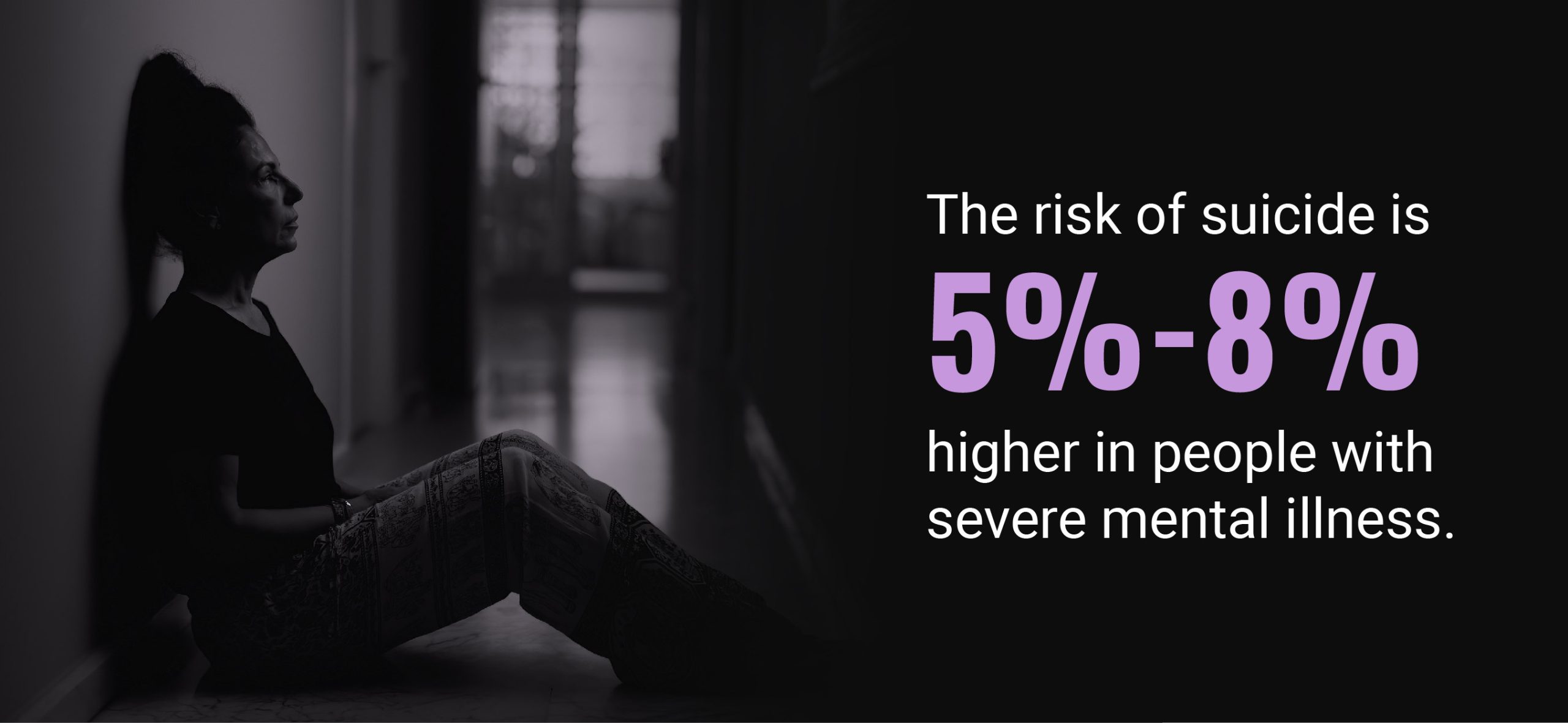
One study also showed that individuals diagnosed with a mental illness a year before their deaths were 6.8 times more likely to die by suicide [65].
According to the same study, depression caused 27% of suicide deaths. Anxiety disorders make up 22% of suicide deaths, while bipolar disorder makes up 8%. Schizophrenia and ADHD make up 2% and 1% of suicide deaths, respectively [65].
46% of suicide deaths had a comorbid mental illness diagnosis [34]. Psychological autopsy also found that 90% of suicide deaths may have experienced mental illness symptoms [22].
Suicide deaths make up 45,979 deaths each year [33]. 79% of suicide deaths are males [35].
Suicidal Thoughts in the US Statistics
4.9% or 12.2 million American adults above 18 had serious suicidal thoughts in 2020 [57].
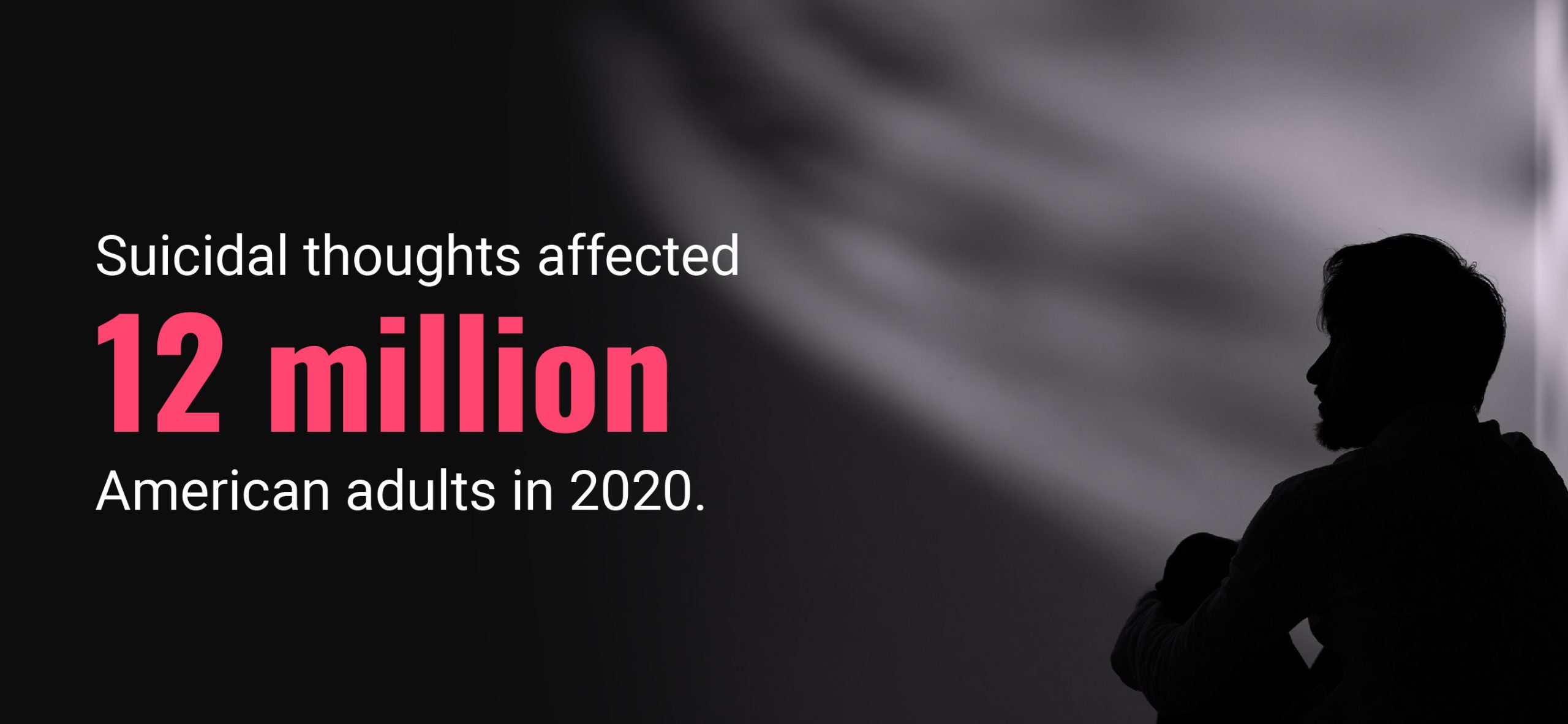
45% of youths belonging to the LGBTQ community have suicidal thoughts [1]. High school students follow next, with 18.8% of them dealing with these negative thoughts [11]. Suicidal thoughts occur the least among young adults (18 to 25) at 11.3% [57].
Students identifying as LGB are more than 3 times as likely to have made suicide plans as their heterosexual peers [11].
40% of transgender adults have attempted to commit suicide in their lifetime. It’s nearly 9x higher than the general population’s suicide attempt rate [50].
Worldwide, mental illness accounts for 14.3% of the total deaths each year or 8 million deaths [61].
Of those with mental disorders, 67.3% died from natural causes. 17.5% died from unnatural causes, which include suicide deaths. 15.2% have unknown causes [61].
Is Mental Illness on the Rise?
There had been a 3.3 percentage point increase in mental illness prevalence rate. From 17.7% in 2008, mental illness prevalence rate increased to 21% [45].
The number of people with mental illness also increased by 32.7% — from 39.83 million in 2017 to 52.86 million in 2020 [45].
Mental Health Medications Statistics
According to the CDC, 20.3% of adults in the US received treatment for mental health in 2020 [58].
Of this percentage, 16.5% took medications and 10.1% underwent therapy or received counseling [58].
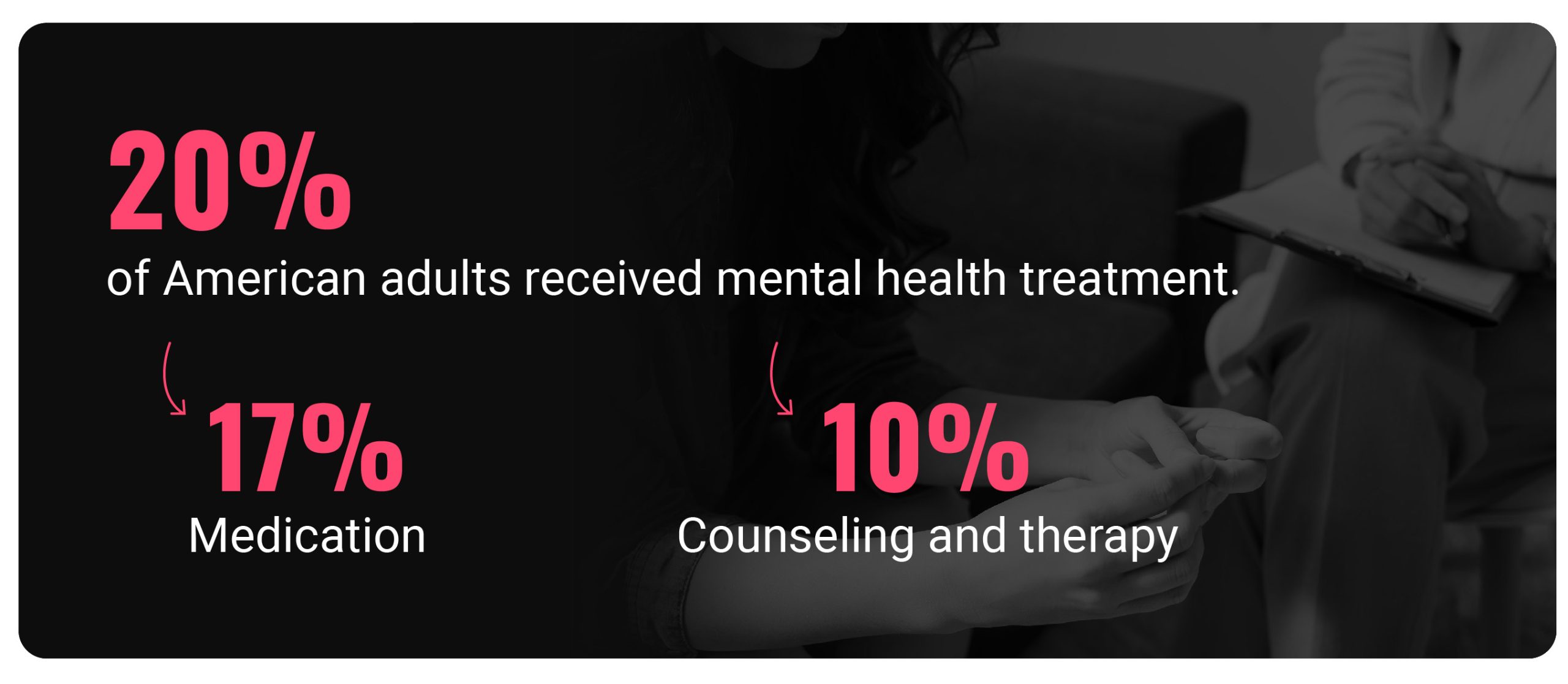
21.2% of those who took medications are women and 11.5% are men [58].
12.1% of those who underwent therapy or received counseling are women and 7.9% are men [58].
A 2020 Substance Abuse and Mental Health Services Administration (SAMHSA) report showed that, of the 52.9 million Americans with mental illness, 46.2% or 24.3 million received treatment [57].
30.5% or 16.1 million say their needs for mental health treatment were unmet. Of this percentage, 48% or 7.7 million did not receive any treatment [57].
Of those who received treatment, 38.8% took prescription medications for their symptoms. 28.5% received outpatient care, while 2.9% necessitated inpatient care [57].
Of the 14.2 million with severe mental illness, 64.5% or 9.1 million received treatment. 35.5% or 5 million did not receive any treatment [57].
55.9% took prescription medications, while 45.1% received outpatient services. 6.5% needed inpatient services [57].
Among adolescents and youths (6 to 17 years) with mental illness, 50.6% of them received treatment for their symptoms. 49.4% did not receive treatment [63]. This data came from a 2016 study.
According to the CDC, 78.1% or nearly 4 in 5 children with depression had treatment. Of those with children with anxiety, 59.3% or nearly 3 in 5 also received treatment [36]. This data also came from a 2016 CDC report.
The combination of medications and therapy help improve symptoms in 70% to 90% of people with serious mental illness [32].
CBD for Mental Health Statistics
A 2022 survey shows that 51% of CBD users in the US take CBD for anxiety. 62% say they use it for stress reduction [28].
58% use CBD for sleep problems, and 48% say their doctors recommended CBD use [28].
Gummies are the preferred CBD form, with 58% of CBD users consuming CBD edibles [29].
55% take CBD capsules for their symptoms, and 55% also use CBD oils and tinctures [29].
A study on CBD users and self-perceived symptoms also found that 42.6% of their subjects used CBD for anxiety. 37.5% also used CBD to reduce stress [31].
42.5% used it for sleep, while 37% for general wellbeing [31].
About 15% of them also use CBD for depression symptoms and about 5% for PTSD. Less than 5% also use CBD for ADHD [31].
Is CBD Good for Mental Health?
86.5% or more than 4 in 5 of those who used it for self-perceived anxiety say it made them less anxious. Only 12.9% say CBD has no effects on their anxiety [31].
Of those who used CBD for self-perceived stress, 92.2% or 9 in 10 say they felt less stressed on CBD. 7.8% say CBD made no difference in their symptoms [31].
71.4% or nearly 3 in 4 reported no adverse effects on CBD [31].
CBD also produced some side effects, with dry mouth being reported by 11.3% of the participants [31].
3.4% say CBD caused fatigue [31].
Less common side effects (each with less than 2% of the respondents) include [31]:
- Dizziness
- Headaches
- Nausea
- Anxiety
- Inability to concentrate
- Symptoms of psychosis
- Tachycardia or fast heartbeat
- Indigestion or upset stomach
- Diarrhea
- Sexual problems
More than 10% say CBD made them feel less depressed [31].
Another study also found that taking CBD for eight weeks decreased the severity of symptoms in 91% of 11 PTSD patients. The participants also reported improvement in their nightmare symptoms. All PTSD patients reported no adverse effects [15].
Mental Illness and Recovery Rate Statistics
67% or about two-thirds of people suffering from any form of mental illness recover. They will at least meet the criteria for symptomatic recovery [4].

Recovery-remission is also possible in people with serious mental illness.
Of the 16.9% diagnosed with serious mental illness, 5.8% of them met the criteria for lifetime diagnosis. Of this percentage, 32.6% have been in recovery-remission for over a year [53].
3.9% continue to experience symptoms of serious mental illness [53].
Final Thoughts
Mental illness affects 21% of adults and 23.2% of children in the US. It’s a highly treatable disorder, but only 46.2% of adults and 50.6% of children with mental disorders receive treatment.
If left untreated, it increases suicide risks. Of the total suicide deaths, 46% of them can be attributed to mental illness.
If you or a loved one is suffering from this disorder, please know that you are not alone and seek help. You may get in touch with the following organizations:
- Substance Abuse and Mental Health Services Administration (SAMHSA): 1-800-662-HELP (4357), 1-800-985-5990, or visit samhsa.gov for support or more information.
- National Alliance on Mental Illness (NAMI): 800-950-6264, 703-524-7600, or visit nami.org
References
- 2022 National Survey on LGBTQ Youth Mental Health. (2022). The Trevor Project. [1]
- Anker, J., & Krill, P. R. (2021). Stress, drink, leave: An examination of gender-specific risk factors for mental health problems and attrition among licensed attorneys. PLoS One, 16(5), e0250563. [2]
- Anxiety and Depression. (2022). Centers for Disease Control and Prevention. [3]
- Association for Psychological Science. (2022). Good news: People can recover and thrive after mental illness and substance-use disorders. ScienceDaily. [4]
- Blackwelder, A., Hoskins, M., & Huber, L. (2021). Effect of Inadequate Sleep on Frequent Mental Distress. Preventing Chronic Disease, 18. [5]
- Brådvik, L. (2018). Suicide Risk and Mental Disorders. International Journal of Environmental Research and Public Health, 15(9), 2028. [6]
- Canadian Mental Health Association. (2008). The Relationship between Mental Health, Mental Illness and Chronic Physical Conditions. CMHA Ontario. [7]
- COVID-19 and Mental Health: A Growing Crisis. (2021). Mental Health America. [8]
- Daré, L. O., Bruand, P. E., Gérard, D., Marin, B., Lameyre, V., Boumédiène, F., & Preux, P. M. (2019). Co-morbidities of mental disorders and chronic physical diseases in developing and emerging countries: a meta-analysis. BMC Public Health, 19, 304. [9]
- Deloitte Access Economics. (2020). The Social and Economic Cost of Eating Disorders in the United States of America: A Report for the Strategic Training Initiative for the Prevention of Eating Disorders and the Academy for Eating Disorders. Harvard T.H. Chan School of Public Health. [10]
- Division of Adolescent and School Health. (2019). Youth Risk Behavior Survey Data Summary & Trends Report: 2009-2019. Centers for Disease Control and Prevention. [11]
- Division of Adolescent and School Health. (2020). Mental Health. Centers for Disease Control and Prevention. [12]
- Do, T. T. H., Correa-Velez, I., & Dunne, M. P. (2019). Trauma Exposure and Mental Health Problems Among Adults in Central Vietnam: A Randomized Cross-Sectional Survey. Frontiers in Psychiatry, 10. [13]
- Elflein, J. (2022). Schizophrenia prevalence by gender U.S. 2019. Statista. [14]
- Elms, L., Shannon, S., Hughes, S., & Lewis, N. (2019). Cannabidiol in the Treatment of Post-Traumatic Stress Disorder: A Case Series. The Journal of Alternative and Complementary Medicine, 25(4), 392–397. [15]
- Floen, S. K., & Elklit, A. (2007). Psychiatric diagnoses, trauma, and suicidiality. Annals of General Psychiatry, 6, 12. [16]
- Gender Differences in Addiction. (2022). Aventis Graduate School. [17]
- George, E. S., Davidson, I., El Masri, A., Meade, T., & Kolt, G. S. (2022). Unhealthy Lifestyle Behaviours and Psychological Distress: A Longitudinal Study of Australian Adults Aged 45 Years and Older. International Journal of Environmental Research and Public Health, 19(7), 4399. [18]
- He, Q., Turel, O., Brevers, D., & Bechara, A. (2017). Excess social media use in normal populations is associated with amygdala-striatal but not with prefrontal morphology. Psychiatry Research: Neuroimaging, 269, 31–35. [19]
- Here’s How Social Media Affects Your Mental Health. (2020). McLean Hospital. [20]
- Impact of Social Media on Youth Mental Health. (2019). University of Nevada, Reno. [21]
- Isometsä, E. T. (2001). Psychological autopsy studies – a review. European Psychiatry, 16(7), 379–385. [22]
- Kang, H. K., Rhodes, C., Rivers, E., Thornton, C. P., & Rodney, T. (2021). Prevalence of Mental Health Disorders Among Undergraduate University Students in the United States: A Review. Journal of Psychosocial Nursing and Mental Health Services, 59(2), 17–24. [23]
- Karim, F., Oyewande, A., Abdalla, L. F., Chaudhry Ehsanullah, R., & Khan, S. (2020). Social Media Use and Its Connection to Mental Health: A Systematic Review. Cureus, 12(6), e8627. [24]
- Kessler, R. C., Adler, L., Barkley, R., Biederman, J., Conners, C. K., Demler, O., Faraone, S. V., Greenhill, L. L., Howes, M. J., Secnik, K., Spencer, T., Ustun, T. B., Walters, E. E., & Zaslavsky, A. M. (2006). The Prevalence and Correlates of Adult ADHD in the United States: Results From the National Comorbidity Survey Replication. American Journal of Psychiatry, 163(4), 716–723. [25]
- Kessler, R. C., Angermeyer, M., Anthony, J., DE Graaf, R., Demyttenaere, K., Gasquet, I., DE Girolamo, G., Gluzman, S., Gureje, O., Haro, J. M., Kawakami, N., Karam, A., Levinson, D., Medina Mora, M. E., Oakley Browne, M. A., Posada-Villa, J., Stein, D. J., Adley Tsang, C. H., Aguilar-Gaxiola, S., . . . Ustün, T. B. (2007). Lifetime prevalence and age-of-onset distributions of mental disorders in the World Health Organization’s World Mental Health Survey Initiative. World Psychiatry: Official Journal of the World Psychiatric Association (WPA), 6(3), 168–176. [26]
- Margalit, L. (2015). Why We’re Addicted to Our Smartphones, But Not Our Tablets. Psychology Today. [27]
- Mikulic, M. (2022a). Leading reasons for CBD use U.S. 2022. Statista. [28]
- Mikulic, M. (2022b). Preferred CBD product types U.S. 2022. Statista. [29]
- Mohamed, I. I., Ahmad, H. E. K., Hassaan, S. H., & Hassan, S. M. (2020). Assessment of anxiety and depression among substance use disorder patients: a case-control study. Middle East Current Psychiatry, 27, 22. [30]
- Moltke, J., & Hindocha, C. (2021). Reasons for cannabidiol use: a cross-sectional study of CBD users, focusing on self-perceived stress, anxiety, and sleep problems. Journal of Cannabis Research, 3(1). [31]
- National Alliance on Mental Illness. (2020). About Mental Illness. NAMI California. [32]
- National Center for Health Statistics. (2014). Mental Health. Centers for Disease Control and Prevention. [33]
- National Center for Injury Prevention and Control. (2018). Suicide rising across the US. Centers for Disease Control and Prevention. [34]
- National Center for Injury Prevention and Control. (2021). WISQARS (Web-based Injury Statistics Query and Reporting System). Centers for Disease Control and Prevention. [35]
- National Center on Birth Defects and Developmental Disabilities. (2016). Data and Statistics on Children’s Mental Health. Centers for Disease Control and Prevention. [36]
- National Institute of Mental Health. (2021a). Attention-Deficit/Hyperactivity Disorder (ADHD). National Institutes of Health. [37]
- National Institute of Mental Health. (2021b). Bipolar Disorder. National Institutes of Health. [38]
- National Institute of Mental Health. (2021c). Mental Illness. National Institutes of Health. [39]
- National Institute of Mental Health. (2021d). Obsessive-Compulsive Disorder (OCD). National Institutes of Health. [40]
- National Institute of Mental Health. (2021e). Personality Disorders. National Institutes of Health. [41]
- National Institute of Mental Health. (2021f). Post-Traumatic Stress Disorder (PTSD). National Institutes of Health. [42]
- National Institutes of Health (US); Biological Sciences Curriculum Study. (2007). NIH Curriculum Supplement Series [Internet]: Information about Mental Illness and the Brain. In Bethesda (MD): National Institutes of Health (US). [43]
- National Survey of Children’s Health (NSCH). (2021). Health Resources & Services Administration. [44]
- National Survey on Drug Use and Health (NSDUH). (2022). Substance Abuse and Mental Health Services Administration (SAMHSA). [45]
- New data reveal extent of genetic overlap between major mental disorders. (2013). National Institutes of Health. [46]
- Pedrelli, P., Nyer, M., Yeung, A., Zulauf, C., & Wilens, T. (2015). College Students: Mental Health Problems and Treatment Considerations. Academic Psychiatry: The Journal of the American Association of Directors of Psychiatric Residency Training and the Association for Academic Psychiatry, 39(5), 503–511. [47]
- Primack, B. A., Shensa, A., Escobar-Viera, C. G., Barrett, E. L., Sidani, J. E., Colditz, J. B., & James, A. E. (2017). Use of multiple social media platforms and symptoms of depression and anxiety: A nationally-representative study among U.S. young adults. Computers in Human Behavior, 69, 1–9. [48]
- Primack, B. A., Shensa, A., Sidani, J. E., Whaite, E. O., Lin, L. Y., Rosen, D., Colditz, J. B., Radovic, A., & Miller, E. (2017). Social Media Use and Perceived Social Isolation Among Young Adults in the U.S. American Journal of Preventive Medicine, 53(1), 1–8. [49]
- The Report of the 2015 U.S. Transgender Survey. (2017). National Center for Transgender Equality. [50]
- Ridley, M., Rao, G., Schilbach, F., & Patel, V. (2020). Poverty, depression, and anxiety: Causal evidence and mechanisms. Science, 370(6522). [51]
- Riehm, K. E., Feder, K. A., Tormohlen, K. N., Crum, R. M., Young, A. S., Green, K. M., Pacek, L. R., La Flair, L. N., & Mojtabai, R. (2019). Associations Between Time Spent Using Social Media and Internalizing and Externalizing Problems Among US Youth. JAMA Psychiatry, 76(12), 1266–1273. [52]
- Salzer, M. S., Brusilovskiy, E., & Townley, G. (2018). National Estimates of Recovery-Remission From Serious Mental Illness. Psychiatric Services, 69(5), 523–528. [53]
- Schizophrenia – Fact Sheet. (2022). Treatment Advocacy Center. [54]
- Social Media Fact Sheet. (2021). Pew Research Center. [55]
- Study Finds Sex Differences in Mental Illness. (2011). American Psychological Association. [56]
- Substance Abuse and Mental Health Services Administration (SAMHSA). (2021). Key substance use and mental health indicators in the United States: Results from the 2020 National Survey on Drug Use and Health. Center for Behavioral Health Statistics and Quality. [57]
- Terlizzi, E. P., & Norris, T. (2021). Mental Health Treatment Among Adults: United States, 2020. In Centers for Disease Control and Prevention (No. 419). National Center for Health Statistics. [58]
- Terlizzi, E. P., & Schiller, J. S. (2021). Estimates of Mental Health Symptomatology, by Month of Interview: United States, 2019. Centers for Disease Control and Prevention. [59]
- University of Pittsburgh Schools of the Health Sciences. (2016). Greater social media use tied to higher risk of eating, body image concerns. ScienceDaily. [60]
- Walker, E. R., McGee, R. E., & Druss, B. G. (2015). Mortality in Mental Disorders and Global Disease Burden Implications. JAMA Psychiatry, 72(4), 334–341. [61]
- Wallace, J. B. (2021). Instagram is even worse than we thought for kids. What do we do about it? The Washington Post. [62]
- Whitney, D. G., & Peterson, M. D. (2019). US National and State-Level Prevalence of Mental Health Disorders and Disparities of Mental Health Care Use in Children. JAMA Pediatrics, 173(4), 389–391. [63]
- Xiong, J., Lipsitz, O., Nasri, F., Lui, L. M., Gill, H., Phan, L., Chen-Li, D., Iacobucci, M., Ho, R., Majeed, A., & McIntyre, R. S. (2020). Impact of COVID-19 pandemic on mental health in the general population: A systematic review. Journal of Affective Disorders, 277, 55–64. [64]
- Yeh, H. H., Westphal, J., Hu, Y., Peterson, E. L., Williams, L. K., Prabhakar, D., Frank, C., Autio, K., Elsiss, F., Simon, G. E., Beck, A., Lynch, F. L., Rossom, R. C., Lu, C. Y., Owen-Smith, A. A., Waitzfelder, B. E., & Ahmedani, B. K. (2019). Diagnosed Mental Health Conditions and Risk of Suicide Mortality. Psychiatric Services, 70(9), 750–757. [65]
- Younghans, J. (2018). College Stress. Harvard Medical School. [66]
- Zlotnick, C., Clarke, J. G., Friedmann, P. D., Roberts, M. B., Sacks, S., & Melnick, G. (2008). Gender differences in comorbid disorders among offenders in prison substance abuse treatment programs. Behavioral Sciences & the Law, 26(4), 403–412. [67]